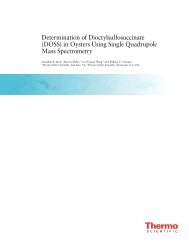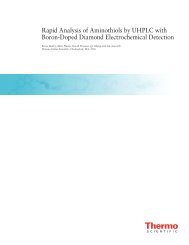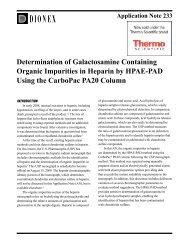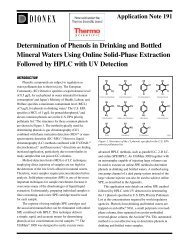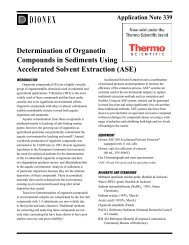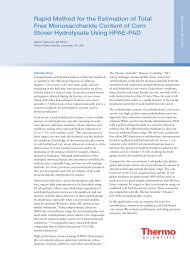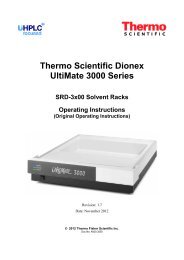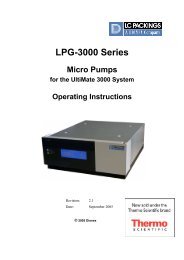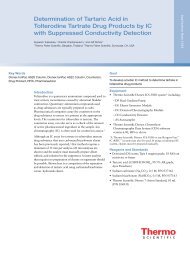AutoTrace 280 Details - Dionex
AutoTrace 280 Details - Dionex
AutoTrace 280 Details - Dionex
You also want an ePaper? Increase the reach of your titles
YUMPU automatically turns print PDFs into web optimized ePapers that Google loves.
Introduction<br />
Page 1 of 4<br />
Volume 2 November 2010<br />
• ASE/AT Features and Benefits<br />
• Application Notes<br />
Features Unique to ASE Benefits to Oil and Grease Analysis<br />
True Walk-away Automation Overnight Extraction = Higher Productivity<br />
Automated Solvent Mixing Automated Method Development<br />
Flow-through Design Removal of Interferences During Extraction<br />
Combined Static/Dynamic Extractions Exhaustive Extraction = Increased Recoveries<br />
Automatic Rinsing System Rinsed with Any Solvent Automatically<br />
Low Solvent Use Reduced Sample Costs<br />
Features Unique to <strong>AutoTrace</strong> <strong>280</strong> Benefits to Oil and Grease Analysis<br />
Positive Pressure Controllable Flow Rate = Higher Recoveries<br />
6-sample Capacity Increased Throughput<br />
Elution Solvent Volumes can be Set by User Consistent Final Volumes<br />
SPE Disk or Cartridge Configuration Available Flexible for Customer Preference<br />
Low Solvent Use Reduced Sample Costs<br />
• Literature References<br />
• Customer References<br />
Accelerated Solvent Extraction (ASE ® ) and <strong>AutoTrace</strong> ® <strong>280</strong> Sample Prep for PAH and TPH Analysis<br />
Polycyclic aromatic hydrocarbons (PAHs) are compounds found in oil, coal, and tar deposits. They consist of bound aromatic rings, and<br />
have been identified as potentially carcinogenic and mutagenic to humans and other animals. PAH pollutants can be found in soil,<br />
sediment, sludge, water, and food products, including various animal tissues. Total petroleum hydrocarbons (TPH) is a term used to<br />
describe a large family of chemical compounds found in crude oil (including PAHs).<br />
With increased concern about the environmental impact of recent oil spills, laboratories have been working hard to provide analysis on<br />
oil and grease samples quickly. ASE and <strong>AutoTrace</strong> <strong>280</strong> provide fast, automated sample preparation for these types of samples. Many<br />
laboratories have already purchased these systems to dramatically increase their throughput of hydrocarbon contaminated samples. ASE<br />
extracts PAHs from soil, sediment, sludge, food and animal tissue, quickly and using low amounts of organic solvents. ASE is accepted<br />
under EPA method 3545A. <strong>AutoTrace</strong> <strong>280</strong> extracts TPH from water samples using automated solid-phase extraction technology. <strong>AutoTrace</strong><br />
<strong>280</strong> is accepted under EPA method 1664A for extraction of oil and grease from water samples using either SPE disk or cartridge.<br />
ASE and <strong>AutoTrace</strong> <strong>280</strong> Features and Benefits to Oil and Grease Analysis
ASE <strong>Details</strong><br />
Overnight Extraction = Higher Productivity<br />
True walk-away automation is very beneficial to labs extracting<br />
PAHs because it will increase throughput as sample prep tends to<br />
be the bottleneck in the process. It is important to understand that<br />
an entire rack of 24 samples can be set up at the beginning of the<br />
day and another rack of 24 samples can be set up to run overnight<br />
providing extracts that are ready for analysis first thing in the<br />
morning. With minimal user intervention, 48 samples or more<br />
per day can be extracted and ready for analysis. No other sample<br />
preparation process available offers this type of automation.<br />
Automated Method Development<br />
ASE instrumentation can be programmed to deliver solvents in the<br />
ratios desired for the type of extractions needed. This automation<br />
simplifies method development because each cell can be extracted<br />
with a different solvent or solvent mixture. Different batches<br />
of samples can be processed as part of the same sample batch<br />
because the solvent composition can be programmed to change<br />
for the samples being extracted. The method will tell the system to<br />
automatically change solvents and rinse the lines with any solvent<br />
needed. No other sample preparation system offers this level of<br />
flexibility and usability.<br />
Removal of Interferences During Extraction<br />
Solvent enters the top of the ASE extraction cell and exits the bottom<br />
along with the analytes. This design allows various adsorbents to be<br />
added to the bottom of the cell to remove unwanted co-extractables.<br />
The ASE system design can therefore help eliminate post-extraction<br />
cleanup steps and speed the sample prep process. This capability is<br />
especially important to laboratories performing PAH extraction from<br />
animal tissue—a sample that often has contaminants that interfere<br />
with analysis. (See Tech Note 210 under ASE PAH/TPH Application<br />
Notes)<br />
Exhaustive Extraction = Increased Recoveries<br />
ASE is the only extraction method that provides both a dynamic and<br />
static extraction in the same extraction run. Dynamic extraction is the<br />
ability to introduce fresh solvent during the extraction process. This<br />
ensures that the extraction solvent will not become oversaturated<br />
with the analyte, decreasing its ability to remove more analyte.<br />
Static extraction is holding the extraction solvent and sample for<br />
a set period of time to maximize the solubility of the analytes.<br />
Performing both dynamic and static extractions is what defines<br />
ASE as an exhaustive extraction technique, and provides maximum<br />
analyte recoveries.<br />
Automatic Rinsing<br />
The automatic rinse function allows the user to set up different<br />
batches of samples for the same extraction run using different<br />
solvents for each batch. The system will automatically change<br />
solvents and rinse the entire system with the next solvent to be<br />
used. There is no need for user intervention. This is important to<br />
laboratories extracting PAHs from various sample matrices. Up to<br />
24 samples can be extracted with any number of combinations of<br />
sample matrices and/or extraction methods. ASE is the only<br />
extraction method to offer automatic rinsing.<br />
Page 2 of 4<br />
<strong>AutoTrace</strong> <strong>280</strong> <strong>Details</strong><br />
Controllable Flow Rate = Higher Recoveries<br />
Using positive pressure for sample pumping and elution gives a<br />
constant controllable flow, which allows total petroleum hydrocarbons<br />
(TPH) more time to bind to the SPE material. This allows for<br />
better recoveries with higher reproducibility than vacuum systems.<br />
<strong>AutoTrace</strong> <strong>280</strong> is the only large-volume automated SPE system<br />
to use positive pressure rather than vacuum for disk or<br />
cartridge extraction.<br />
Increased Throughput<br />
The <strong>AutoTrace</strong> <strong>280</strong> allows six samples to be loaded simultaneously<br />
onto SPE cartridge or disks, enabling automated sequential sample<br />
elution. This increases sample throughput dramatically, which is<br />
very important when extracting large batches of oil and grease<br />
samples. <strong>AutoTrace</strong> <strong>280</strong> is the only automated SPE system that<br />
offers the ability to extract six samples in a single system.<br />
Consistent Final Volumes<br />
Having the ability to control the final volume of the extracts is<br />
very helpful when extracting TPH from water. The final volumes are<br />
consistent, and smaller final volumes translate into lower evaporation<br />
times and faster results. Vacuum systems have inconsistent final<br />
volumes. Only <strong>AutoTrace</strong> <strong>280</strong> offers this feature.<br />
Flexible for Customer Preference<br />
The <strong>AutoTrace</strong> <strong>280</strong> is the only automated SPE extraction system<br />
to offer customers a choice of ordering an SPE disk or cartridge<br />
configuration. Flexibility is important for customers when choosing<br />
the right extraction system for their needs. That is why <strong>Dionex</strong> offers<br />
many different configurations for the <strong>AutoTrace</strong> <strong>280</strong>.<br />
ASE-PAH/TPH Application Notes<br />
AN 313: Extraction of PAHs from Environmental Samples Using<br />
Accelerated Solvent Extraction (ASE)<br />
Overview: The procedures described in this application note meet<br />
the requirements for the extraction of PAHs from solid waste as<br />
described in U.S. EPA Method 3545. This method is applicable to<br />
solid wastes including soils, sludges, and sediments.<br />
AN 324: Accelerated Solvent Extraction (ASE) of Hydrocarbon<br />
Contaminants (BTEX, Diesel, and TPH) in Soils<br />
Overview: This note reports the use of ASE for the extraction of<br />
diesel fuel, gasoline (BTEX), and total petroleum hydrocarbons<br />
(TPH) from soils.<br />
AN 338: Extraction of Total Petroleum Hydrocarbon Contaminants<br />
(Diesel and Waste Oil) in Soils by Accelerated Solvent<br />
Extraction (ASE)<br />
Overview: This application note reports on the use of ASE for the<br />
extraction of diesel range organics (DRO), waste oil organics (WOO),<br />
and total petroleum hydrocarbons (TPH, the sum of DRO and WOO)<br />
from soils.
AN 359: Extraction of Contaminants, Pollutants, and Poisons from<br />
Animal Tissue Using Accelerated Solvent Extraction (ASE)<br />
Overview: This application note details procedures for extracting<br />
the following contaminants from animal tissues:<br />
• Dioxins/Furans<br />
• Polybrominated Flame Retardants (PBDE)<br />
• PCBs<br />
• Pesticides<br />
• PAHs<br />
• Organotin<br />
TN 210: Accelerated Solvent Extraction (ASE) Techniques for In-line<br />
Selective Removal of Interferences<br />
Overview: This technical note summarizes seven ASE procedures<br />
developed to remove co-extractable material from various matrices,<br />
including procedures to selectively extract polar compounds from<br />
lipid-rich samples and to fractionate lipids from biological samples.<br />
This note serves as a guide to develop ASE methods.<br />
<strong>AutoTrace</strong> <strong>280</strong> TPH<br />
Application Notes<br />
AN 817: EPA Method 1664A–Extraction of Oil and Grease from Water<br />
Samples Using <strong>AutoTrace</strong> <strong>280</strong> Solid-Phase Extraction Cartridge<br />
Configuration<br />
Overview: This application note describes the use of the <strong>AutoTrace</strong><br />
<strong>280</strong> instrument to extract oil and grease from water samples in<br />
accordance with the EPA Method 1664, Revision A.<br />
AN 818: EPA Method 1664A–Extraction of Oil and Grease from<br />
Water Samples Using <strong>AutoTrace</strong> <strong>280</strong> Solid-Phase Extraction<br />
Disk Configuration<br />
Overview: This application note describes the use of the <strong>AutoTrace</strong><br />
<strong>280</strong> instrument to extract oil and grease from water samples in<br />
accordance with the EPA Method 1664, Revision A.<br />
Literature References<br />
19. F. Höfler, D. Jensen, J. Ezzell, B. Richter.<br />
ASE of PAH from solid samples with subsequent HPLC analysis.<br />
Chromatographie. 1995, Jan, 68-71.<br />
28. N. Saim, J.R. Dean, Md.P. Abdullah, Z. Zakaria. An experimental<br />
design approach for the determination of polycyclic aromatic<br />
hydrocarbons from highly contaminated soil using ASE.<br />
Analytical Chemistry. 1998: 70, 420-424.<br />
114. B. Richter. Extraction of hydrocarbon contamination<br />
from soils using accelerated solvent extraction. Journal of<br />
Chromatography A. 2000: 874, 217-224.<br />
123. S. Lundstedt, B. van Bavel, P. Haglund, M. Tysklind, L. Oberg.<br />
Pressurized liquid extraction of polycyclic aromatic hydrocarbons<br />
from contaminated soils. Journal of Chromatography A.<br />
2000: 883, 151-162.<br />
Page 3 of 4<br />
193. A. Hubert, K-D Wenzel, W. Engelwald, G. Schuurman. ASE-<br />
More efficient extraction of POPs and PAHs from real<br />
contaminated plant and soils. Reviews in Analytical Chemistry. 2001,<br />
101-143.<br />
201. S. Tao, Y.H. Cui, J. Cao, F.L. Xu, R. Dawson, B.G. Li. Determination<br />
of PAHs in wastewater irrigated agricultural soil using ASE.<br />
Journal Environmental Health and Science. 2002: B37, 141-150.<br />
242. L. Turrio-Baldassarri, C.L. Battistelli, A.L. Iameceli. Evaluation<br />
of the efficiency of extraction of PAH’s from diesel particulate<br />
matter with pressurized solvents. Anal Bioanal. Chem. 2003: 375,<br />
589-595.<br />
286. J. Hollender, B. Koch, C. Lutermann, W. Dott. Efficiency of<br />
different methods and solvents for the extraction of polycyclic<br />
aromatic hydrocarbons from soils. Intern. J. Environ. Anal. Chem.<br />
:83, 21-32.<br />
303. J.H. Kim, J.K. Moon, Q.X. Li, J.Y. Cho. One-step pressurized<br />
liquid extraction method for the analysis of polycyclic aromatic<br />
hydrocarbons. Analytic Chimica Acta. 2003, 55-60.<br />
325. N. Alexandrou, M. Smith, R. Park, K. Lumb, K. Brice. The extraction<br />
of polycyclic aromatic hydrocarbons from atmospheric<br />
particulate matter samples by accelerated solvent extraction<br />
(ASE). Intern. J. Environ. Anal. Chem. 2001: 81, 257-<strong>280</strong>.<br />
390. M.R. Burkhardt, S.D. Zaugg, T.L. Burbank, M.C. Olsen, J.L. Iverson.<br />
Pressurized liquid extraction using water/isopropanol coupled<br />
with solid-phase extraction cleanup for semivolatile organic<br />
compounds, polycyclic aromatic hydrocarbons (PAH), and<br />
alkylated PAH homolog groups in sediment. Analytica Chimica<br />
Acta. 2005: 549, 104-116.<br />
413. V. Yusa, O. Pardo, P. Marti, A. Pastor. Applications of accelerated<br />
solvent extraction followed by gel performance chromatography<br />
and high-performance liquid chromatography for the<br />
determination of polycyclic aromatic hydrocarbons in mussel<br />
tissue. Food Additives and Contaminants. 2005, 482-489.<br />
414. A. Dreyer, M. Radke. Evaluation and optimization of extraction<br />
and clean-up methods for the analysis of polycyclic aromatic<br />
hydrocarbons in peat samples. International Journal of<br />
Environmental Analytical Chemistry. 2005: 85, 423-432.<br />
433. B-C. Lee, Y. Shimizu, T. Matsuda, S. Matsui. Characterization<br />
of polycyclic aromatic hydrocarbons (PAHs) in different size<br />
fractions in deposited road particles (DRPs) from Lake Biwa<br />
area, Japan. Environmental Science and Technology. 2005: 39,19,<br />
7402-7409.<br />
450. S. Lundstedt, P. Haglund, L. Oberg. Simultaneous extraction<br />
and fractionation of polycyclic aromatic hydrocarbons and their<br />
oxygenated derivatives in soil using selective pressurized liquid<br />
extraction. Analytical Chemistry. 2006: 78,9, 2993-3000.<br />
459. M.A. Olivella. Trace analysis of polycyclic aromatic<br />
hydrocarbons in suspended particulate matter by accelerated<br />
solvent extraction followed by gas chromatography-mass<br />
spectrometry. Anal Bioanal Chem. 2005: 383, 107-114.
462. E. Perraudin, H. Budzinski, E. Villenave. Analysis of polycyclic<br />
aromatic hydrocarbons adsorbed on particles of atmospheric<br />
interest using pressurized fluid extraction. Anal Bioanal Chem.<br />
2005: 383, 122-131.<br />
471. L. Liguori, K. Heggstad, H.T. Hove, K. Julshamn. An automated<br />
extraction approach for isolation of 24 polyaromatic hydrocarbons<br />
(PAHs) from various marine matrixes. Analytica Chimica Acta.<br />
2006: 573-574, 181-188.<br />
481. M.I.H. Helaleh, A. Al-Omair, A. Nisar, B. Gevao, Z. Bellam.<br />
Soxhlet and accelerated solvent extractions of polycyclic<br />
aromatic hydrocarbons from date palm samples. Chem. Anal.<br />
(Warsaw). 2006: 51, 229-239.<br />
492. M.C. Graham, R. Allan, A.E. Fallick, J.G. Farmer. Investigation of<br />
extraction and clean-up procedures used in the quantification<br />
and stable isotopic characterization of PAHs in contaminated<br />
urban soils. Science of Total Environment. 2006: 360, 81-89.<br />
494. R.C. Brandli, T.D. Bucheli, T. Kupper, F.X. Stadelmann, J.<br />
Tarradellas. Optimized accelerated solvent extraction of PCBs<br />
and PAHs from compost. International Journal of Environmental<br />
Analytical Chemistry. 2006: 86,7, 505-525.<br />
501. H. Yagoh, H. Murayama, T. Suzuki, Y. Tominaga, N. Shibuya, Y.<br />
Masuda. Simultaneous monitoring method of polycyclic<br />
aromatic hydrocarbons and persistent organic pollutants in the<br />
atmosphere using activated carbon fiber filter paper. Analytical<br />
Sciences. 2006: 22, 583-590.<br />
Passion. Power. Productivity.<br />
<strong>Dionex</strong> Corporation<br />
1228 Titan Way<br />
P.O. Box 3603<br />
Sunnyvale, CA<br />
94088-3603<br />
(408) 737-0700<br />
Page 4 of 4<br />
North America<br />
U.S./Canada (847) 295-7500<br />
South America<br />
Brazil (55) 11 3731 5140<br />
Europe<br />
Austria (43) 1 616 51 25 Benelux (31) 20 683 9768; (32) 3 353 4294<br />
Denmark (45) 36 36 90 90 France (33) 1 39 30 01 10 Germany (49) 6126 991 0<br />
Ireland (353) 1 644 0064 Italy (39) 02 51 62 1267 Sweden (46) 8 473 3380<br />
Switzerland (41) 62 205 9966 United Kingdom (44) 1276 691722<br />
558. K. A. Lippa, M. M. Schantz. Microheterogeneity evaluation<br />
of polycyclic aromatic hydrocarbons in particulate standard<br />
reference materials. Anal Bioanal Chem. 2007:387, 2389-2399.<br />
561. B. Veyrand, A. Brosseaud, L. Sarcher, V. Varlet, F. Monteau,<br />
P. Marchand, F. Andre, B. Le Bizec. Innovative method for determination<br />
of 19 polycyclic aromatic hydrocarbons in food and oil<br />
samples using gas chromatography coupled to tandem mass<br />
spectrometry based on an isotope dilution approach. Journal of<br />
Chromatography A. 2007:1149, 333-344.<br />
571. W. Wang, B. Meng, X. Lu, Y. Liu, S. Tao. Extraction of polycyclic<br />
aromatic hydrocarbons and organochlorine pesticides from<br />
soils: A comparison between Soxhlet extraction, microwave-<br />
assisted extraction and accelerated solvent extraction<br />
techniques. Analytical Chimica Acta. 2007: 602, 211-222.<br />
582. N. Itoh, M. Numata, Y. Aoyagi, T. Yarita. Comparison of<br />
low-level polycyclic aromatic hydrocarbons in sediment<br />
revealed by Soxhlet extraction, microwave-assisted extraction,<br />
and pressurized liquid extraction. Analytical Chimica Acta. 2008:<br />
612, 44-52.<br />
Customer References<br />
Names of scientists using ASE and <strong>AutoTrace</strong> for extraction of PAH<br />
and TPH can be obtained by contacting the Salt Lake Technical<br />
Center directly or via email asesupport@dionex.com.<br />
ASE and UltiMate are registered trademarks of <strong>Dionex</strong> Corporation. ASPEC is a trademark of Gilson Incorporated.<br />
All other trademarks and registered trademarks are the property of <strong>Dionex</strong> Corporation.<br />
Asia Pacific<br />
Australia (61) 2 9420 5233 China (852) 2428 3282 India (91) 22 2764 2735<br />
Japan (81) 6 6885 1213 Korea (82) 2 2653 2580 Singapore (65) 6289 1190<br />
Taiwan (886) 2 8751 6655<br />
www.dionex.com<br />
LPN 2685 PDF 11/10<br />
©2010 <strong>Dionex</strong> Corporation




